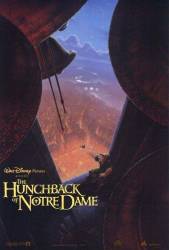Continuity mistake: During the introduction to Phoebus and Esmeralda, Djali drops a bunch of coins. All through the scene, there are no coins on the ground; the coins reappear for Phoebus to throw them to Esmeralda (in her old man disguise). (00:17:20 - 00:18:35)
Factual error: Towards the end of the song "Out There" Quasimodo climbs onto the large spire on the roof. That spire was added in the 19th century and thus didn't exist when the movie was set.
Factual error: During the song "A Guy Like You," one of the gargoyles trips the trapdoor on Quasimodo's miniature hangman's scaffold. Trapdoors weren't used on scaffolds until the 18th century.
Factual error: When Quasimodo and Esmerelda are on the roof of the cathedral, a piece of the roof breaks off and slides with them standing on it. The material creates sparks as it slides. The material would be either copper or (more likely) lead, neither of which can be made to spark.
Factual error: The statues outside of Notre Dame Cathedral are shown as plain stone, as they appear in modern times, although in the story's period (the fifteenth century) they were polychromed.
Continuity mistake: In the scene where Quasimodo is reciting his alphabet to Frollo, we see Frollo pick up his goblet for a drink when he says "D?" By "E?", he still has the goblet in his hand. After saying "F?" he raises the goblet and takes a drink. When the camera pans back to Quasimodo saying "Festival", the goblet is in clear sight even when we hear Frollo spit out his drink.
Factual error: After Phoebus distracts the guards to stop them from chasing Esmeralda, we see the goat smoking a pipe to give the appearance of a beggar. Tobacco (and consequently, smoking pipe) wasn't introduced in Europe for at least another century, as it's a plant native to the Americas.
Continuity mistake: During the song "Hellfire," Frollo pulls out Esmeralda's ribbon and you see him holding it throughout the song. When the monks in the red cloaks appear, the ribbon is gone to appear again moments later. Then when the soldier walks into the room, the ribbon has disappeared for a second time, then when he leaves, it is in plain sight in Frollo's hand again.
Plot hole: When Quasimodo is revealed to the crowd during the Festival of Fools, someone identifies him as "the bell-ringer from Notre Dame." This is the first time Quasimodo has ever left the cathedral, so he shouldn't know that.
Factual error: At one point, Quasimodo says, "At sunset, I ring the evening mass, and after that, I clean the cloisters, and then I ring the vespers, and..." In fact, evening masses were not permitted by the church until the twentieth century.
Revealing mistake: At the start of the montage in which Frollo ransacks Paris for the gypsy girl, the shot of the three soldiers kicking down the baker's door very briefly places the more distant soldier off to the right "in front" of the closer central soldier; this is a case of incorrect animation cel layering.
Other mistake: During the "Hellfire" sequence, when Frollo is singing "God have mercy on her, God have mercy on me...", his shadow against the wall behind him rises as he backs up closer to the wall. However, when he turns around to press against the wall, his shadow ends up far above his body when it should have become level with his body by that point - like the very next close-up shot of Frollo shows, which is itself a continuity error.






Answer: That's a good question. France actually fought no wars between the Battle of Castillon in 1451, and the Italian Wars which began in 1494. Seeing as the movie takes place in 1482 it seems strange that Phoebus would have fought in any war, unless he is at least 45 years old.